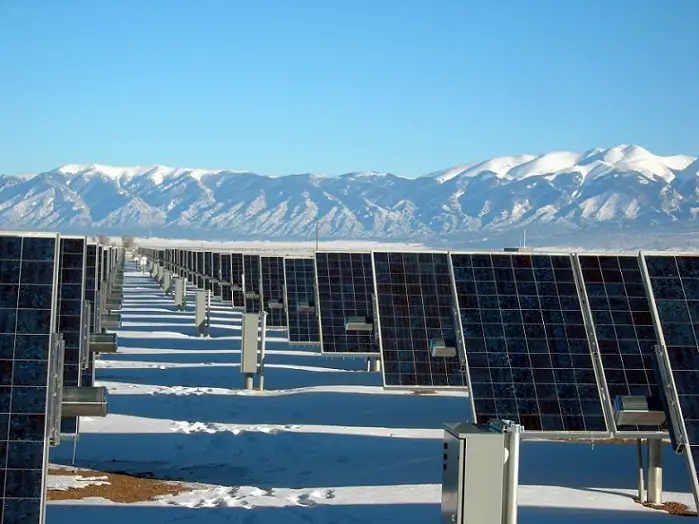Impact of solar panels on Global Warming

We know that fossil fuels cause global warming by emitting large amounts of greenhouse gases. But what about solar panels, which are promoted intensively for producing clean, renewable energy.
Here is what to know about solar panels' contribution to global warming.
Solar panels don't cause global warming because they do not retain heat. They collect sunlight and convert it into electricity using photovoltaic cells. Solar panels create heat, but the amount is negligible when compared to that created by fossil fuels such as oil and coal.
Global warming occurs due to the heat trapped by CO2 and other greenhouse gases. Solar panels reduce CO2 emissions into the atmosphere by generating electricity without the use of fossil fuels.
The reduction in CO2 produced far outweighs any heat generated temporarily by the solar panel absorbing sun rays.
Does panels' black color is a concern?
A lot of people assume that solar panels should retain heat since they are black. However, this is an incorrect assumption. Panels look black due to the light interacts with the silicone layer.
Panels' black color helps the absorption of the light but not the reflection back to the atmosphere to contribute to global warming.
However, It is true that they may become slightly warmer than, say, a white or mirrored roof. Since they can never work at their %100 efficiencies, some of the light they capture does become heat.
How efficient solar panels are converting sunlight into energy?
There are three main methods for converting solar power to electricity.
- Photovoltaic (PV) panels, which convert light directly to electricity,
- Thermophotovoltaic (TPV) panels, which convert radiant heat differentials to electricity via photons,
- Concentrated solar power (CSP), which uses mirrors or lenses to concentrate sunlight to heat a fluid, which drives a turbine and generates power.
The current efficiency of these panels varies from less than 20% (PV) to more than 40% (TPV and CSP), and concentrated PV panels (CPV) utilizing multi-junction can also achieve 40% efficiency.

However, the potential efficiency of solar panels could approach 60%. Here, we can reasonably assume a 30% efficiency by combining CPV and CSP panels but ignoring TPV panels because they are cost-prohibitive to install on a wide scale.
On this basis, we suppose that 25% of incident solar energy is reflected by the solar panels due to glare and glint, or lost due to the conversion from direct current to alternating current and local cable heat loss before the electricity reaches the main grid.
The remaining 90% is split into two parts:
- 30% (of the remaining 90%) is absorbed by the panels and turned to energy,
- 70% (of the remaining 90%) is transmitted through the panels and taken by the underlying surface.
What that means solar power systems are considerably good at converting sunlight into energy without wasting much of it.
Even in the worst-case scenario, a roof with solar panels will not get any hotter than a roof without solar panels. Plus we will have the opportunity to benefit from the power of the sun and help reduce our carbon footprint.
What are the effects of the sun hitting on the solar panel surface?
When the sun hitting on the surface of the solar panels, two effects occur.
Albedo effect
The first effect is known as “albedo,” and it refers to the reflection of sunlight reaching the earth. Because solar panels are black, they have an extremely low albedo. Therefore, they absorb a significant amount of heat from the sun.
There is a widespread misperception that because solar panels appear dark, the waste heat generated by a low albedo contributes to global warming. In most cases, this is incorrect.
A solar panel's albedo depends on the type of technology it uses. However, we can assume it is around 25%, which means that 25% of the sunlight that strikes it is reflected as light into space.
75% of the energy is converted to heat or electricity (which, in turn, is converted to heat when used).
The average albedo of the Earth is also around 30%, which implies that bare earth generates around the same amount of heat like a solar panel, converting sunlight to heat.
Of course, this varies depending on the surface being covered.
Worn or fresh asphalt (and composition tiles on buildings) have an albedo of roughly 0.1 or 10%, thus by covering your house or the neighborhood paved asphalt road with solar panels, you are significantly reducing the amount of waste heat you are dumping into the atmosphere.
Because bare soil has around 17% albedo and desert sand has about 40%, covering desert sand with solar panels may make you somewhat worse off in terms of heat produced, but there is quite a gradient between the desert dirt and desert sand.
In general, the difference between solar panels and most areas covered is nil; both bare areas and solar panels produce the same amount of waste heat, with the added benefit that 15% of your “waste heat” from solar panels becomes electricity before it becomes heat.
You are far ahead of the game if you cover a black roof with solar panels.
The counter effect
The counter effect means using solar power will offset the energy production from the power plants that are run by fossil fuels producing CO₂ and contributing to global warming.

Solar panels can replace energy produced by these plants, and reduce global warming by reducing the amount of released heat-trapping CO2 into the atmosphere.
In conclusion
Although it sounds contrary, the more solar panels we utilize, the less global warming we should expect.
People who try to convince you for the opposite are either don't know what they are talking about or most likely employed somewhere along the supply chain of the fossil fuel industry.



